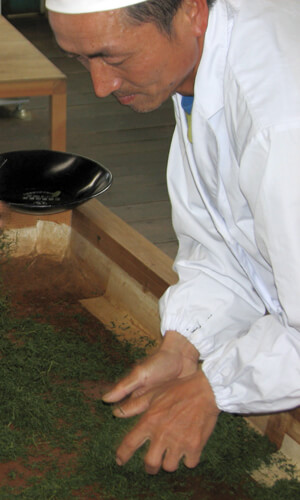Nagashima Takehisa
To ensure the best quality and value, we import our teas directly from the
countries in which they are grown, working closely with the farmers who tender
them.
Our Roots Campaign connects our customers with the rich stories and the farmers behind some of our most popular teas.
Our Roots Campaign connects our customers with the rich stories and the farmers behind some of our most popular teas.
Asahina, Japan

How long have you been growing tea?
“About 50 years. I have been involved in agriculture, especially in green tea fields ever since I graduated from an agricultural high school.”
What got you started in the Tea industry?
“I was the firstborn son of a green tea farming family, so it was a natural choice. Mainly I have been growing green tea, and I also grow Gyokuro.”
Can you describe a typical day out in the field. How many hours would that be?
“To growing Gyokuro, we start out by making shade coverings called "Komo" which is made of black polyester mesh. When green tea bushes' buds start coming out in April, we start putting covering on the frames over the tea bushes. After about 10 days, we cover with two layers, and cut the sun rays by 95%, and we pick them in 20 days.
We pick them by hand, so an adult could only pick 10kg of tea leaves working from 6AM till 6PM. Then finished tea will come out only 2kg. We cannot pick tea leaves on rainy days. After air-dry the leaves in bamboo containers, we start processing them 5AM next morning.”
We pick them by hand, so an adult could only pick 10kg of tea leaves working from 6AM till 6PM. Then finished tea will come out only 2kg. We cannot pick tea leaves on rainy days. After air-dry the leaves in bamboo containers, we start processing them 5AM next morning.”
What is your favorite part of growing tea? What inspires you to keep going?
“When Gyokuro grows up to be what I hoped. When we take good care of the tea bushes, they respond.”
Conversely, what is the hardest part of your job?
“The hardest thing is the climate. When new buds are coming out, frost is our biggest concern. In order to protect the new buds, we need to cover the tea bushes.”
How has tea farming changed over the years?
“The green tea industry will change due to the rise of price of fertilizer, pesticides contrasting with the price of tea going down itself, and a lack of successors to carry on the businesses.”
What do you think makes your tea more unique or better than others?
“We manage all fertilizer and organic manure. We use 100 kg a year. We manage the right steaming temperature like human temperature, and all temperature in manufacturing lines.”
What makes the difference between a successful and unsuccessful harvest?
“As for tea, there is growing and manufacturing. In growing, temperature and pest control is important. In manufacturing, managing raw harvested leaves and the machinery used for processing are important factors.”
Do you exchange growing secrets with other local farmers?
“We often do exchange information with other Gyokuro farmers of the Asahina area in order to improve quality about growing and manufacturing.”
Are there any tips you can give on how to best brew your tea?
“Asahina Gyokuro is best drunken by "TsuyuCha", or drip tea. It is often said that when your throat is thirsty, drink Senhca. When your heart is thirsty, drink Gyokuro. Gyokuro is the best when you brew as the same temperature as a human's skin and drink it slowly over much time.”
What is your favorite tea to drink and why?
“Gyokuro. The sweetness that sweeps in the mouth is just excellent.”
If you had any advice to give western tea drinkers, what would it be?
“Last year, I went to Paris, France to promote Gyokuro with the Okabe Tea Association, and even in France, "TsuyuCha" was popular.”
What does this project & contribution mean to you?
“Thank you for featuring Gyokuro. I want the readers to taste the real Gyokuro.”
view tea >>